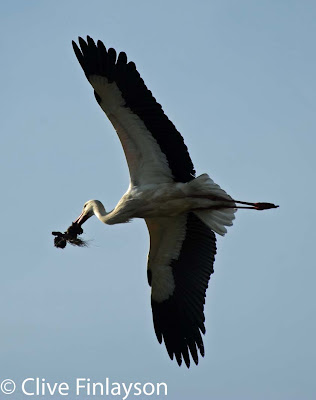The site of a mass of White Storks migrating across the Strait of Gibraltar is still a typical sight in July, August and again between November and April.
These are largely Iberian breeding birds which arrive and go with the rains. Their spring usually starts, variably in October, November or December, depending on when the rains come. Choice of breeding habitat varies. In south-western Iberia many nest in trees (below) and feed in the rich marshes (above), on frogs, crustaceans and fish. Adult peers from nest in eucalypt (above) and two chicks sleep in their tree-top nest (below).
Here they often nest in large colonies alongside Grey Herons and Spoonbills (above) but they may also nest alone (below).
In western Iberia they often feed on the open plains (above). In the absence of trees they often make their nests high in the rooftops of medieval towns (below).
In spring they make the most of the wet and grassy fields in the oak dehesas where they take a variety of prey. Come the summer, when the fields dry up, they exploit the abundance of large insects ahead of the migration south (below).
Bush Crickets (above) and grasshoppers (below) are favourite prey in the early summer.
Traditionally, these storks left with the summer drought to spend the months of July to September in West Africa, south of the Sahara. Here, in places like the wetlands of the Niger in Mali, they would arrive precisely with the monsoon rains. With the end of the rains in October they would start returning north to catch the start of the rains north of the Sahara Desert.
...but for a few years now this pattern has started to change with many storks never leaving at all.
They have the advantage that, being on or close to the breeding grounds, they can time the start of nesting much better than their counterparts in Africa.so what has changed?
we changed! We developed the habit of creating large, open air, rubbish tips and the adaptable storks learnt to scavenge here during the breeding season. Food was easy to get and, as the supply did not vary with the season, they never left.
so storks now patiently line up and wait for the next refuse lorry which brings many potential meals!
so we can imagine a time when we produce so much refuse and have so many such tips, that the entire pattern of the storks' behaviour will have changed from migratory to resident.






















These pictures are absolutely breath-taking. We see the same type of behavioral changes, caused by much the same thing over here in the Midwest U.S. concerning our Canadian Geese population. Many birds that before would move on with the weather change, now choose to stay year round because of the ample food supply.
ReplyDeletethank you for your remarks Laura. I think that sometimes we attribute behaviours to climate change that have more to do with our direct activities.
ReplyDelete